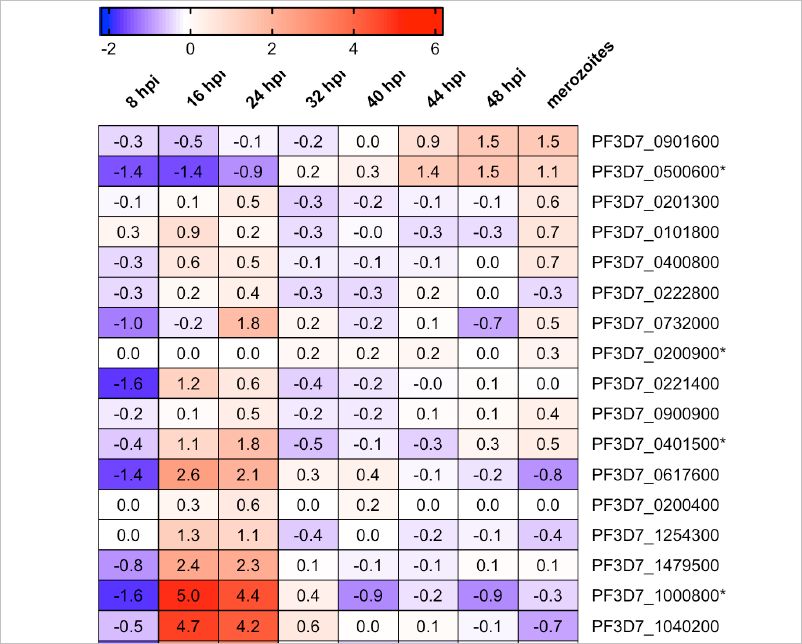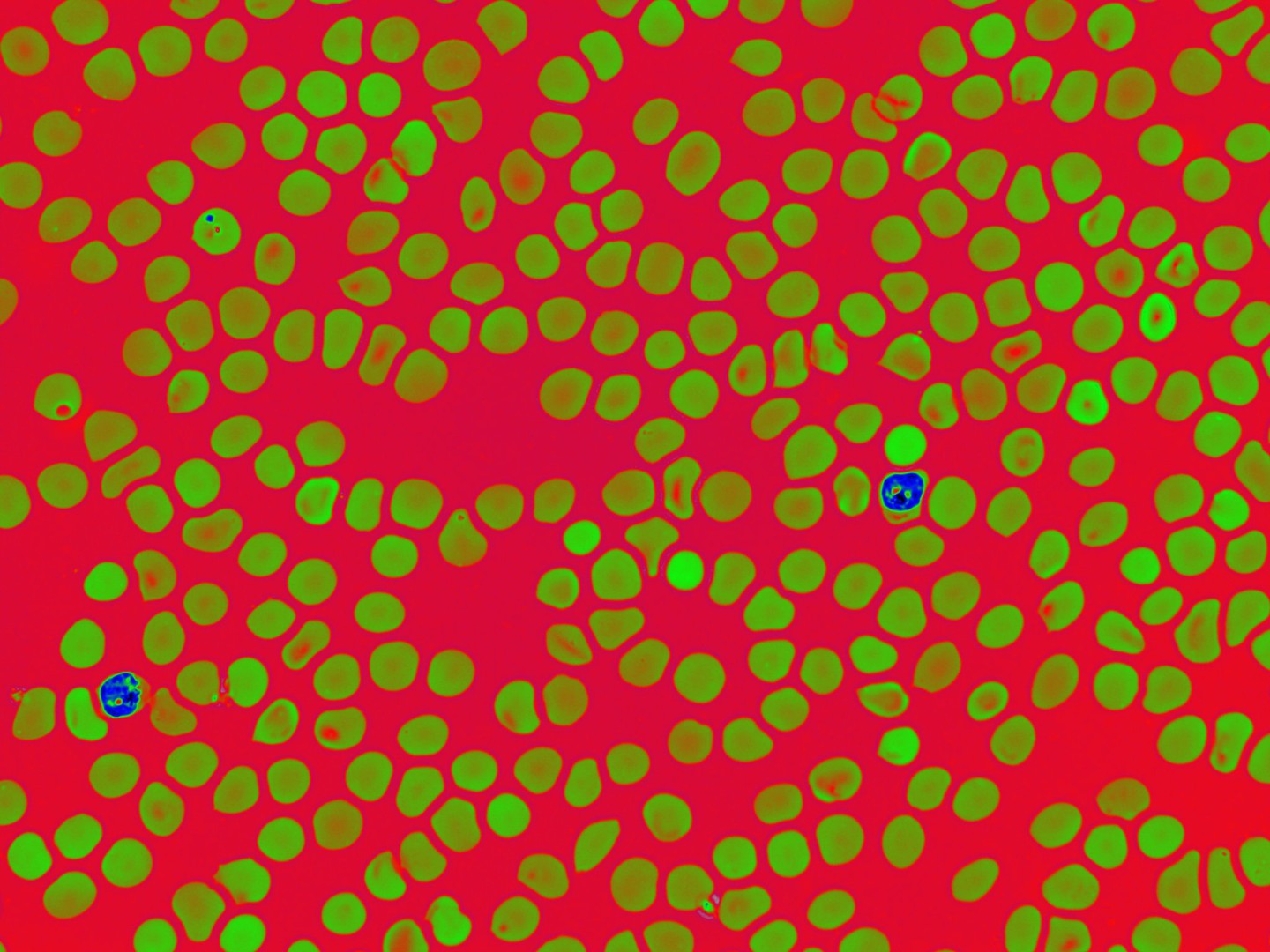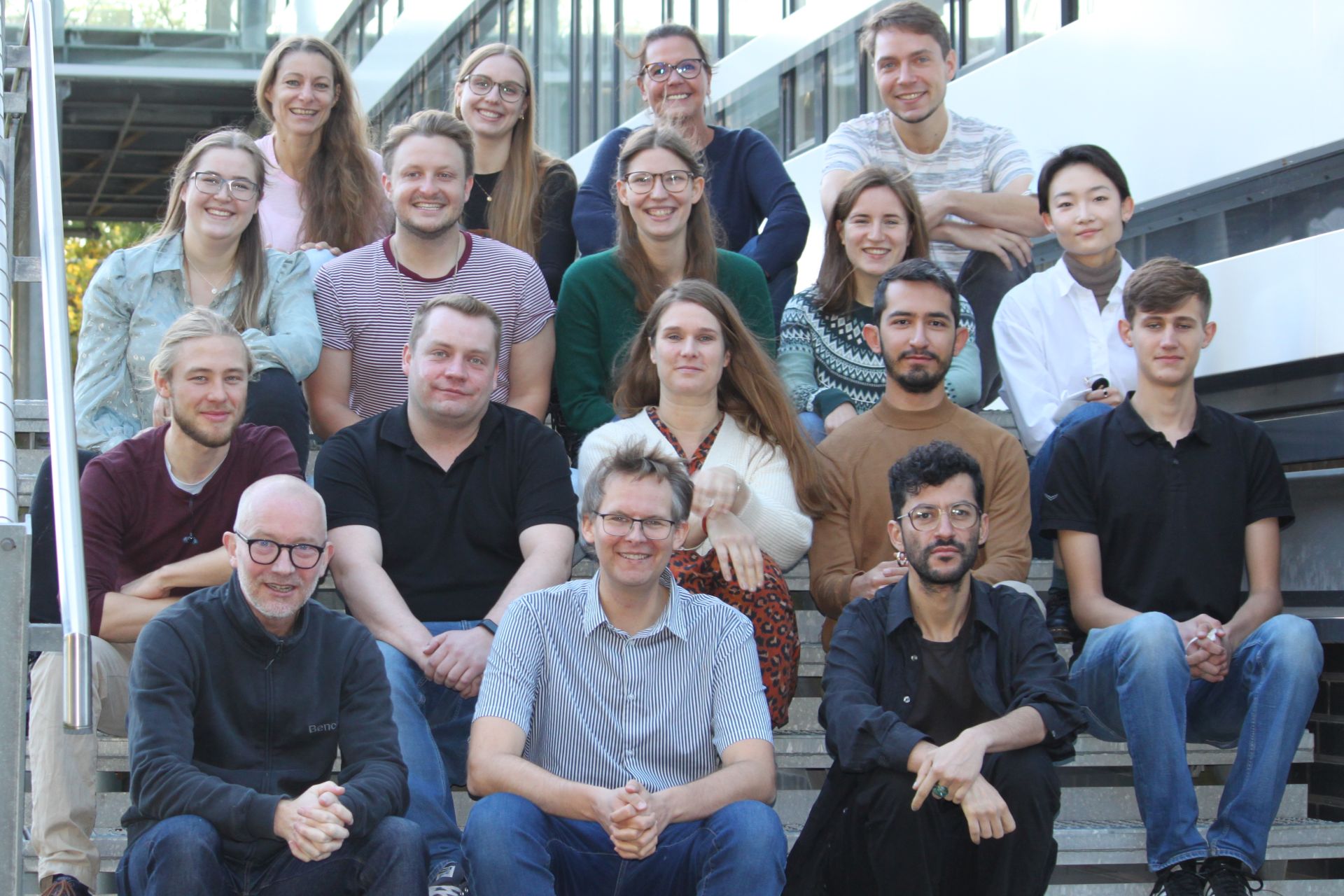Publications
2014
Kumar P, Tripathi A, Ranjan R, Halbert J, Gilberger T, Doerig C, Sharma P (2014) Regulation of Plasmodium falciparum development by calcium-dependent protein kinase 7 (PfCDPK7). J Biol Chem. 289:20386-95. doi: 10.1074/jbc.M114.561670.
2013
Tomlins A, Ben-Rached F, Williams R, Proto W, Coppens I, Ruch U, Gilberger T, Coombs G, Mottram J, Müller S, Langsley G (2013) Plasmodium falciparum ATG8 implicated in both autophagy and apicoplast formation. Autophagy. 9: 1540-52.
Heiber A, Kruse F, Pick C, Grüring C, Flemming S, Oberli A, Schoeler H, Retzlaff S, Mesén-Ramírez P, Hiss J, Kadekoppala M, Hecht L, Holder AA, Gilberger T, Spielmann T (2013) Identification of new PNEPs indicates a substantial non-PEXEL exportome and underpins common features in Plasmodium falciparum protein export. PLoS Pathog. 9: e1003546.
Kono M, Prusty D, Parkinson J, Gilberger T (2013) The apicomplexan inner membrane complex. Front Biosci. 18: 982-92.
Dahan-Pasternak N, Nasereddin A, Kolevzon N, Pe'er M, Wong W, Shinder V, Turnbull L, Whitchurch C, Elbaum M, Gilberger T, Yavin E, Baum J, Dzikowski R, (2013) PfSec13 is an unusual chromatin associated nucleoporin of Plasmodium falciparum, which is essential for parasite proliferation in human erythrocytes. J Cell Sci. 126: 3055-69.
Engelberg K, Paul A, Prinz B, Kono M, Ching W, Heincke D, Dobner T, Spielmann T, Duraisingh M, Gilberger T (2013) Specific phosphorylation of the PfRh2b invasion ligand of Plasmodium falciparum. Biochem J. 452: 457-66.
Mueller C, Kalges N, Cabrera A, Gilberger T, Dubremetz J, Soldati-Favre D (2013) Apical positioning of rhoptries is mediated by palmitoylated ARO and is essential for Toxoplasma host cell invasion but not egress. Cell Host Microbes. 13: 289-301.
2012
Cabrera A, Herrmann S, Warszta D, Santos JM, John Peter AT, Kono M, Debrouver S, Jacobs T, Spielmann T, Ungermann C, Soldati-Favre D, Gilberger T (2012) Dissection of minimal sequence requirements for rhoptry membrane targeting in the malaria parasite. Traffic. 13: 1335-50.
Kono M, Herrmann S, Loughran NB, Cabrera A, Engelberg K, Lehmann C, Sinha D, Prinz B, Ruch U, Heussler V, Spielmann T, Parkinson J, Gilberger T (2012) Evolution and architecture of the inner membrane complex in asexual and sexual stages of the malaria parasite. Mol Biol Evol. 29: 2113-32.
Hoeijmakers W, Salcedo-Amaya A, Smits A, Françoijs K, Treeck M Gilberger, T Stunnenberg, H Bártfai, R (2012) H2A.Z/H2B.Z double-variant nucleosomes inhabit the AT-rich promoter regions of the Plasmodium falciparum genome. Mol Micro. 87: 1061-73.
Yahata K, Treeck M, Culleton R, Gilberger T, Kaneko O (2012) Time-lapse imaging of red blood cell invasion by rodent malaria parasit. PlosOne. 7: e50780.
Grüring C, Heiber A, Kruse F, Flemming S, Franci G, Colombo S, Fasana E, Schöler H, Borgese N, Stunnenberg H, Przyborski J, Gilberger T, Spielmann T (2012) Common principles in malaria protein export. Cell Host Microbes. 12: 417-29.
Dixon M, Dearnley M, Hanssen E, Gilberger T, Tilley L (2012) Shape-shifting gametocytes: how and why does P. falciparum go banana-shaped? Trends Parasitol. 28: 471-8.
Thomas D, Ahmed A, Gilberger T, Sharma P (2012) Regulation of Plasmodium falciparum Gildeosome Associated Protein 45 (GAP45) by phosphorylation. PloSOne. 7, e35855.
Deshmukh AS, Srivastava S, Herrmann S, Gupta A, Mitra P, Gilberger T, Dhar S (2012) The role of N-terminus of Plasmodium falciparum ORC1 in telomeric localization and var gene silencing. Nucleic Acid Res. 40: 5313-31.
2011
Bachmann A, Predehl S, May J, Harder S, Burchard GD, Gilberger T, Tannich E, Bruchhaus I (2011) Highly co-ordinated var gene expression and switching in clinical Plasmodium falciparum isolates from non-immune malaria patients. Cell Microbiol. 13: 1397-409.
malERA Consultative Group on Basic Science and Enabling Technologies (2011) A research agenda for malaria eradication: basic science and enabling technologies. PLoS Med. 8: e1000399. Review.
Grüring C, Heiber A, Ungefehr U, Gilberger T, Spielmann T* (2011) Development and Host Cell Modifications of Plasmodium falciparum Blood Stages in 4D. Nat. Comm. 2, 165. *Corresponding authors.
2010
Bártfai R, Hoeijmakers W, Salcedo-Amaya A, Smits A, Janssen-Megens E, Kaan A, Treeck M, Gilberger T, Françoijs K, Stunnenberg H (2010) H2A.Z demarcates intergenic regions of the Plasmodium falciparum epigenome that are dynamically marked by H3K9ac & H3K4me3. PloS Pathogens 6:e1001223.
Leykauf K*, Treeck M*, Gilson P, Nebl T, Braulke T, Cowman A, Gilberger T**, Crabb** B (2010) Protein kinase A-dependent phosphorylation of apical membrane antigen plays an important role in erythrocyte invasion by the malaria parasite PloS Pathogens 6: e1000941. *Joint first authors, **Corresponding authors
Weiss R, Gabler M, Jacobs T, Gilberger T, Thalhamer J, Scheiblhofer S (2010) Differential effects of C3d on the immunogenicity of gene gun vaccines encoding Plasmodium falciparum and Plasmodium berghei MSP1(42). Vaccine 28: 4515-22.
Schottelius J, Gilberger T, Ehrhardt S, Burchard G (2010) Plasmodium knowlesi: cause of naturally acquired malaria in humans. Dtsch. Med. Wochenschr. 135: 297-300.
Hu* G, Cabrera* A, Mok S, Kono M, Cheemadan S, Haase S, Chaal BK, Wastuwidyaningtyas D, Spielmann T, Preiser P, Gilberger** T, Bozdech** Z (2010) Plasmodium falciparum protein function predicted by a high confidence interactome network. Nat. Biotechnol. 28:91-98. *Joint first authors, **Corresponding authors.
Spielmann T, Gilberger T (2010) Protein export in malaria parasites: do multiple export motifs add up to multiple export pathways? Trends Parasitol., 26: 6-10.
2009
Treeck M, Tamborrini M, Daubenberger C, Gilberger T, Voss T (2009) Caught in action: mechanistic insight into antibody-mediated inhibition of Plasmodium merozoite invasion. Trends Parasitol. 25: 494-497.
Treeck M, Zacherl S, Herrmann S, Haase S Engelberg K, Kono M, Struck N, Cabrera A, Frischknecht F Miura, K Spielmann, T Gilberger, T (2009) Functional analysis of the leading malaria vaccine candidate AMA-1 reveals an essential role for the cytoplasmic domain in the invasion process. PloS Pathogens 5: e1000322.
Wickramarachchi T, Cabrera A, Sinha D, Dhawan S, Chandran T, Devi Y, Kono M, Spielmann T, Chauhan* VS, Gilberger* T, Mohmmed* A (2009) A Novel Plasmodium falciparum Erythrocyte Binding Protein Associated with the Merozoite Surface, PfDBLMSP. Int. J. Parasitol. 39: 763-773 *Corresponding authors.
Haase S, Herrmann S, Langer C, Treeck M, Cabrera A, Jansen P, Struck N, Kono M, Stunnenberg H, Gilberger* T, Spielmann* T (2009) A short motif necessary for export links REX2 and SBP1 with the PEXEL pathway in P. falciparum. Mol. Micro. 71: 1003-1017. * Corresponding authors.
2008
Baum J, Gilberger T, Frischknecht F, Meissner M (2008): Malaria parasite host-cell invasion: insights from across the Plasmodium lifecycle and Toxoplasma (Review). Trends Parasitol. 24: 557-563.
Struck N, Herrmann S, Langer C, Krueger A, Foth BJ, Engelberg K, Cabrera AL, Haase S, Treeck M, Marti M, Cowman AF, Spielmann T, Gilberger T (2008) Plasmodium falciparum possesses two GRASP proteins that are differentially targeted to the Golgi complex via a higher- and lower-eukaryote-like mechanism. J. Cell Sci. 121: 2123-29.
Struck N, Herrmann S, Schmuck-Barkmann I, de Souza Diaz S, Haase S, Cabrera AL, Treeck M, Bruns C, Langer C, Cowman AF, Marti M, Spielmann T, Gilberger T (2008) Restricted ER export competence and Spatial dissection of the cis- and Trans-Golgi compartments in the malaria parasite Plasmodium falciparum. Mol. Micro. 67: 1320-30.
Haase S, Cabrera A, Langer C, Treeck T, Struck N, Herrmann S, Jansen PW, Bruchhaus I, Bachmann A, Dias S, Cowman AF, Stunnenberg HG, Spielmann T, Gilberger, T (2008) Characterization of a conserved rhoptry-associated leucine zipper-like protein in the malaria parasite Plasmodium falciparum. Infect. Immun. 76: 879-887.
2007
Jackson KE, Spielmann T, Hanssen E, Adisa A, Separovic F, Dixon MW, Trenholme KR, Hawthorne PL, Gardiner DL, Gilberger T, Tilley L (2007) Selective permeabilization of the host cell membrane of Plasmodium falciparum-infected red blood cells with streptolysin O and equinatoxin II. Biochem J. 403: 167-175.
Spielmann T, Gilberger T (2007) New therapeutic approaches for malaria: molecular aspects of erythrocyte invasion. Dtsch Med Wochenschr. 132: 2383-6.
2006
O´Donnell R, Hackett F, Howell SA, Treeck M, Struck NS, Krnajski Z, Withers-Martinez C, Gilberger* T, Blackmann* MJ (2006) Intermembrane proteloysis mediates shedding of a key adhesin during erythrocyte invasion by the malaria parasite. J Cell Biol 174: 1023-33. * Corresponding authors.
Eschbach ML, Müller IB, Gilberger T, Walter RD, Wrenger C (2006) The human malaria parasite Plasmodium falciparum expresses an atypical N-terminally extended pyrophosphokinase with specificity for thiamine. Biol. Chem. 387: 1583-91.
Treeck M, Struck NS, Haase S, Langer C, Herrmann S, Healer J, Cowman AF, Gilberger T (2006) A conserved region in the EBL-proteins is implicated in microneme targeting of the malaria parasite Plasmodium falciparum. J. Biol. Chem. 281: 31995-2003.
Baum J, Richard D, Healer J, Rug M, Krnajski Z, Gilberger T, Green JL, Holder AA, Cowman A (2006) A conserved molecular motor drives cell invasion and gliding motility across malaria lifecycle stages and other apicomplexan parasites. J. Biol. Chem. 281: 5197-208.
2005
Struck NS, de Souza Dias S, Langer C, Marti M, Pearce JA, Cowman AF, Gilberger T (2005) Re-defining the Golgi complex in P. falciparum using the novel Golgi marker PfGRASP. J. Cell Sci. 118: 5603-13.
Haider N, Eschbach ML, Dias S, Gilberger T, Walter RD, Lüersen K (2005) The spermidine synthase of the malaria parasite Plasmodium falciparum: molecular and biochemical characterization of the polyamine synthesis enzyme. Mol. Biochem. Parasitol.142: 224-36.
2004
Crabb BS, Rug M, Gilberger T, Thompson JK, Triglia T, Maier AG, Cowman AF (2004) Transfection of the human malaria parasite Plasmodium falciparum. Methods Mol. Biol. 270: 263-76.
2003
Gilberger T, Thompson JK, Reed MB, Good RT, Cowman AF (2003) The cytoplasmic domain of the Plasmodium falciparum ligand EBA-175 is essential for invasion but not protein trafficking. J Cell Biol 162: 317-27.
Gilberger T, Thompson JK, Triglia T, Good RT, Duraisingh MT, Cowman AF (2003) A novel erythrocyte binding antigen-175 paralogue from Plasmodium falciparum defines a new trypsin-resistant receptor on human erythrocytes. J. Biol. Chem. 278:14480-6.
2002
Krnajski Z, Gilberger T, Walter RD, Cowman AF, Muller S (2002) Thioredoxin reductase is essential for the survival of Plasmodium falciparum erythrocytic stages. J. Biol. Chem. 277: 25970-5.
2001
Muller S, Gilberger T, Krnajski Z, Luersen K, Meierjohann S, Walter RD (2001) Thioredoxin and glutathione system of malaria parasite Plasmodium falciparum. Protoplasma 217: 43-9. Review.
Krnajski Z, Gilberger T, Walter RD, Muller S (2001) The malaria parasite Plasmodium falciparum possesses a functional thioredoxin system. Mol. Biochem. Parasitol. 112: 219-28.
Krause T, Luersen K, Wrenger C, Gilberger T, Muller S, Walter RD (2001) The ornithine decarboxylase domain of the bifunctional ornithine decarboxylase/S-adenosylmethionine decarboxylase of Plasmodium falciparum: recombinant expression and catalytic properties of two different constructs. Biochem. J. 352: 287-92.
2000
Krnajski Z, Gilberger T, Walter RD, Muller S (2000) Intersubunit interactions in Plasmodium falciparum thioredoxin reductase. J. Biol. Chem. 275: 40874-8.
Gilberger T, Schirmer RH, Walter RD, Muller S (2000) Deletion of the parasite-specific insertions and mutation of the catalytic triad in glutathione reductase from chloroquine-sensitive Plasmodium falciparum 3D7. Mol. Biochem. Parasitol. 107:169-79.
1999
Wang PF, Arscott LD, Gilberger T, Muller S, Williams CH Jr. (1999) Thioredoxin reductase from Plasmodium falciparum: evidence for interaction between the C-terminal cysteine residues and the activesite disulfide-dithiol. Biochemistry 38: 3187-96.
1998
Gilberger T, Bergmann B, Walter RD, Muller S (1998) The role of the C-terminus for catalysis of the large thioredoxin reductase from Plasmodium falciparum. FEBS Lett. 425: 407-10.
1997
Gilberger TW, Walter RD, Muller S (1997) Identification and characterization of the functional amino acids at the active site of the large thioredoxin reductase from Plasmodium falciparum. J. Biol. Chem. 272: 29584-9.
Muller S, Gilberger T, Fairlamb AH, Walter RD (1997) Molecular characterization and expression of Onchocerca volvulus glutathione reductase. Biochem. J. 325: 645-51.
1996
Muller S, Gilberger T, Farber PM, Becker K, Schirmer RH, Walter RD (1996) Recombinant putative glutathione reductase of Plasmodium falciparum exhibits thioredoxin reductase activity. Mol. Biochem. Parasitol. 80: 215-9.



















